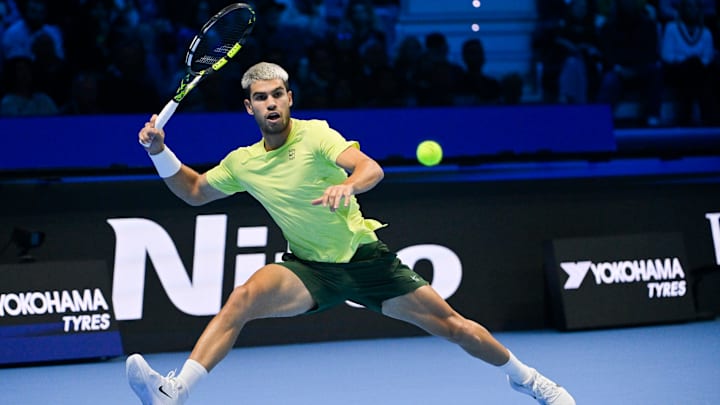Carlos Alcaraz is the No. 1 player in men’s tennis for 2025 – but just barely. Thirty-seven things had to go just right for Alcaraz to finish as the year-end No. 1 for the second time in his career.
Alcaraz finished the 2025 season with a 550-point margin over No. 2 Jannik Sinner in the season-ending ATP rankings after Sinner beat Alcaraz in the title match at the season-ending ATP Finals on Nov. 16.
How easily could that margin have been reversed?
- If any of Alcaraz’s four head-to-head final wins against Sinner in 2025 had gone the other way – at the French Open, U.S. Open, Rome or Cincinnati – then Sinner would have finished No. 1.
- If Alcaraz had lost in the semifinals or earlier at the French Open or U.S. Open, Sinner would have finished No. 1.
- If Alcaraz had lost in the quarterfinals or earlier at Wimbledon, Sinner would have finished No. 1.
- If Alcaraz had lost in the semifinals or earlier at any of the three Masters 1000 events he won this year, Sinner would have finished No. 1.
Who moved up the ATP rankings during the last two months of the season?
That’s 36 matches. Take away any one of those 36 victories, and Alcaraz wouldn’t have finished No. 1.
The 37th thing? Sinner in the spring served a three-month period of ineligibility for an anti-doping rule violation. Sinner very likely would have picked up the 551 points he would have needed to finish as the year-end No. 1 during that time frame.
Instead, Sinner settles for a place in history as the answer to this trivia question: He’s the only player to win two majors and the season-ending championship in the same year, but not finish that year ranked No. 1.
Felix Auger-Aliassime rode the momentum from a semifinal run at the U.S. Open into the fall. He barely squeaked into the year-end championships, but once in the field, he made the most of the opportunity by reaching the semifinals. It added up to a career-best year-end ranking of No. 5 – a jump of eight spots since the U.S. Open.
Valentin Vacherot became the Cinderella story of the ATP season in the last two months. He was No. 205 in the world after the U.S. Open. He had to rally from a set down in each of his qualifying matches just to earn a spot in the main draw at the ATP Masters 1000 event in Shanghai.
He proceeded to knock off seven consecutive better-ranked players to win the whole tournament, the most unlikely ATP Masters run ever. He followed up with a respectable quarterfinal finish at the ATP Masters event in Paris to climb to No. 31 in the world.
Who moved down?
This category could be renamed “who got hurt.” The most impactful ranking slides resulted from injury, not poor performance.
Most significantly, Jack Draper remained inactive after the U.S. Open due to an arm injury and fell from No. 7, which would have been good for a spot in the season-ending championship, to No. 10. Holger Rune suffered a devastating lower leg injury while defending semifinal points in Stockholm and has already dropped four spots to No. 15.
Who’s about to rise?
There’s no obvious candidate for a quick January rankings jump to start 2026, as many of the top younger players are defending not-insignificant ranking points in Australia. However, 19-year-old Joao Fonseca keeps getting better and better, and at No. 24 should be seeded for the Australian Open, and could jump into the top 20 with a solid result or two during the tour’s month Down Under.
Who could fall?
Alexander Zverev and Ben Shelton made the final and semifinal, respectively, at the 2025 Australian Open. If either player suffers an early exit in Melbourne in 2026, they could also exit the top 10.
24 years ago this happened
Lleyton Hewitt rose to No. 1 for the first time and clinched the top ranking for the 2001 season by winning the ATP’s year-end championship – that year called the ATP Cup – in his home country of Australia. Hewitt held the No. 1 ranking for the next 75 weeks.
